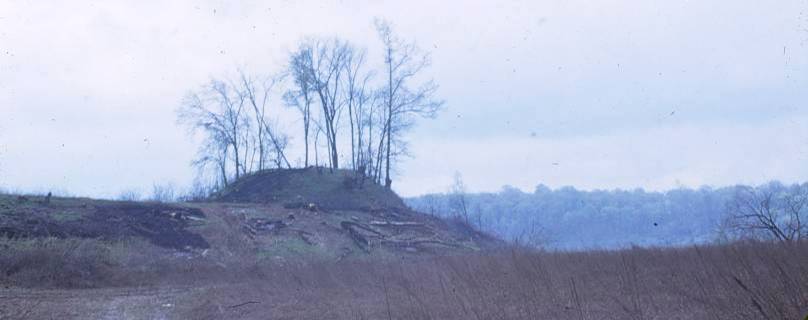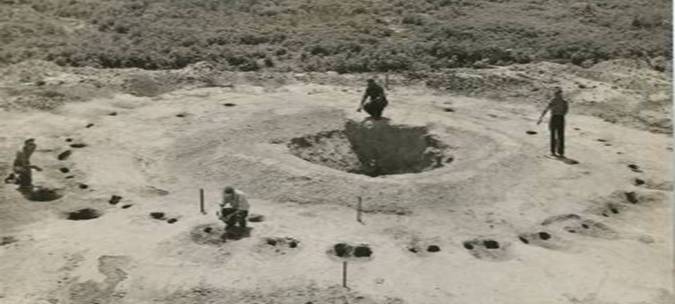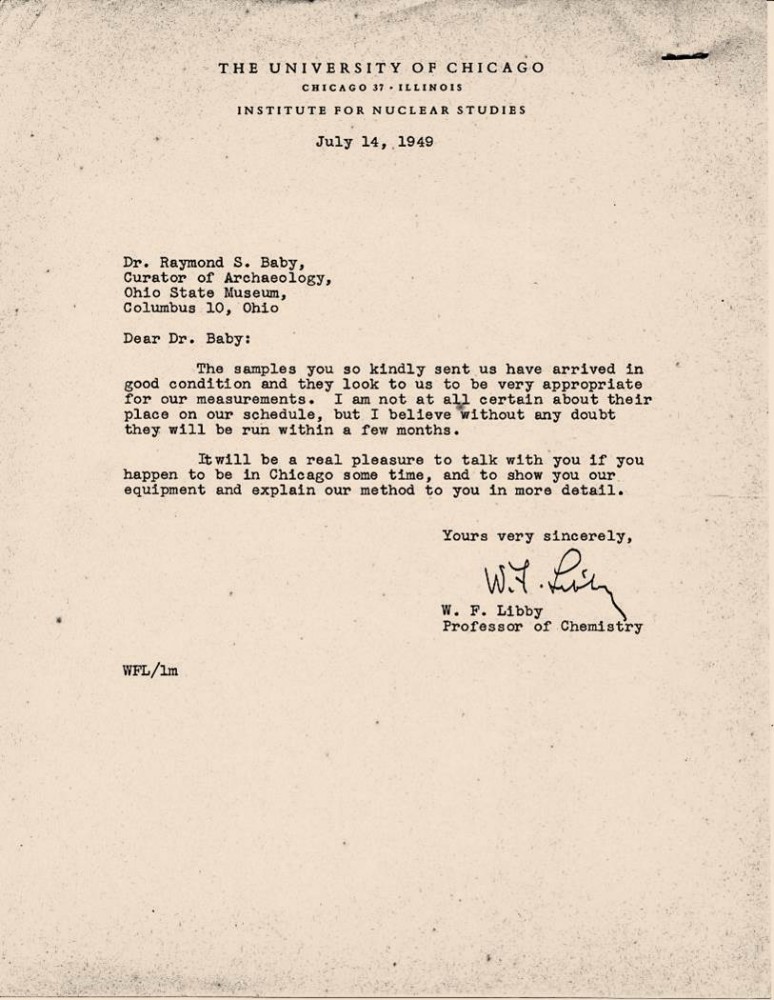Most of us, for better or worse, remember our first date. The Ohio Historical Society’s first ever radiocarbon date for an archaeological site is similarly memorable.

Cowan Creek Mound, April 1949
Cowan Creek Mound, located in Clinton County, Ohio, was 18 feet high and 87 feet in diameter at its base at the time of its excavation. Raymond Baby, then Curator of Archaeology for the Ohio Historical Society, and Robert Goslin directed the salvage excavation in April of 1949. Although, regrettably, Baby never produced a final report on his investigations, the project is a landmark in the history of Ohio archaeology. It resulted in the discovery of a complete circular postmold pattern at the base of the mound, the earliest confirmed evidence for domesticated plants in an Adena site, and charcoal from a fire pit located just outside the circle of posts produced the first radiocarbon date for an Ohio Adena site, which was also the first date obtained on material provided by the Ohio Historical Society. The circular structure was 45 feet in diameter. The postmolds were found in pairs with about 4.5 feet between each set. Baby originally interpreted the circle of posts as a domestic dwelling. It is now thought to have been a specialized mortuary structure for the ceremonies that preceded the building of the mound.

Circular pattern of postmolds discovered beneath the Cowan Creek Mound
The evidence for domesticated plants came from a deposit on the floor of the structure. Volney Jones, a pioneer ethnobotanist at the University of Michigan, stated in his April 1950 report that masses of goosefoot seeds and a few charred squash rind fragments were found “in a pile” associated with “charred fragments of a woven container.”
Jones concluded that the size of the goosefoot seeds suggested they were from a wild, non-domesticated variety. The squash, however, was, according to James Griffin (1951:28), “the first definite evidence of the existence of agriculture in an Adena site.” The charcoal sample used for radiocarbon dating came from a fire pit just outside the structure. According to Baby’s field notes, the pit was “approximately 1.5 ft. deep and about 2 ft. in diameter. This pit was circular and had a flat bottom. On [the] bottom of this pit was a quantity of charred wood and some white wood ashes.” There is some question about the precise date for the mound.
James Arnold, of the Institute for Nuclear Studies at the University of Chicago, informed Baby in a letter dated 10 January 1950 that the radiocarbon date for Cowan Creek Mound was 1550 +/- 250 years ago. Subsequently, James Griffin (1951) reported the date as 1509 +/- 250 and this is the date that was published by Arnold and W. F. Libby in 1951 in the journal Science, which makes it more or less definitive. Regardless, this is one of the youngest dates for any Adena Mound. By contrast, the youngest of the radiocarbon dates we recently obtained for the Adena Mound is 1910 +/- 30 years ago. (Notice how much smaller the standard deviation is for the Adena Mound date. That shows you how much radiocarbon dating has improved since the 1950s.) Thanks to volunteer Sara Nuber Thomas for taking note of the letters regarding the radiocarbon dating of the Cowan Creek Mound in the old correspondence files and for thinking they were particularly relevant to our recent efforts to get radiocarbon dates for the first Adena mound to be excavated by the Ohio Historical Society the Adena Mound.

W.F. Libby’s acknowledgement of receiving the Cowan Creek Mound charcoal samples.
References cited
Griffin, James B. 1951 Some Adena and Hopewell radiocarbon dates. In Memoirs of the Society for American Archaeology, No. 8, Radiocarbon dating: a report on the program to aid in the development of the method of dating. Arnold, J. R. and W. F. Libby 1951 Radiocarbon dates. Science 113(2927):111-120.